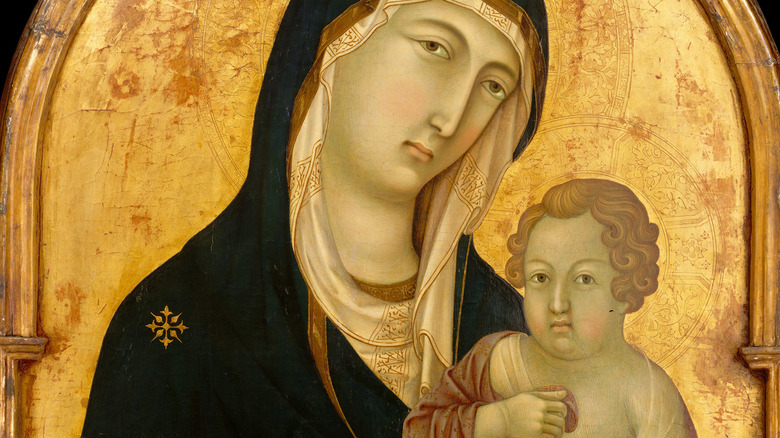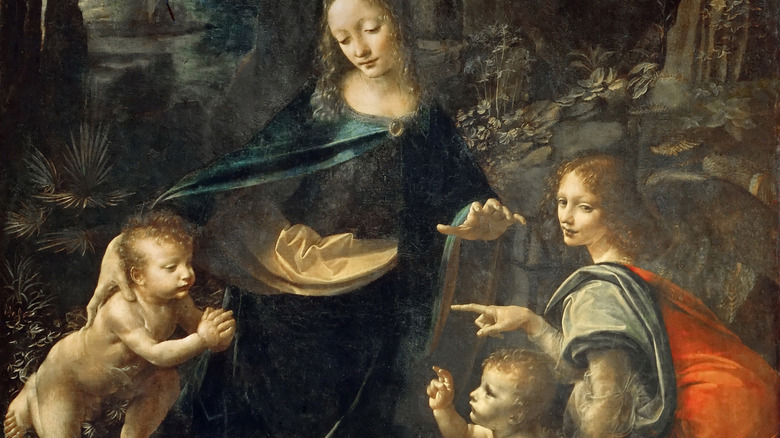Why Babies In Medieval Art Look So Old
If you've spent any time looking at medieval art, you've probably noticed that the depictions of living beings in paintings are, well, weird. There's a reason social media accounts like Twitter's Weird Medieval Guys and Instagram's MedievalReacts are so popular — the representations of people and animals, particularly their faces and expressions, look comical and often ridiculous to 21st-century viewers. This is particularly true when it comes to paintings featuring babies and small children, who are often pictured with aged faces complete with wrinkles, receding hairlines, and world-weary expressions unlikely to be seen on the countenance of anyone under the age of, say, 40. Why were medieval artists so into making babies look like little old men?
It turns out that disinterest in realism was an important element in medieval art. Per art history professor Matthew Averett of Creighton University in an interview with Vox, "The strangeness that we see in medieval art stems from a lack of interest in naturalism, and they veered more toward expressionistic conventions." Artsper magazine observed that medieval art was more focused on symbolism and strict traditions regarding religious iconography as opposed to the realism that became popular during the Renaissance period and beyond. Furthermore, most medieval paintings of babies and children were specifically portraying Jesus Christ. At the time, depictions of Jesus were based on the idea of the homunculus. The word translates to "small man" and in this context, it refers to the wisdom Jesus received directly from God at his birth.
Medieval depictions of children focused on Jesus Christ
Most medieval paintings of children were commissioned by Christian churches, which means that Jesus was generally the subject of the art, according to Vox. As noted by Matthew Averett regarding the influence of the homunculus, "There's the idea that Jesus was perfectly formed and unchanged, and if you combine that with Byzantine painting, it became a standard way to depict Jesus. In some of these images, it looks like he had male pattern baldness."
As Zoe Mann wrote for The Collector, the context in which most people would be interacting with these paintings of Jesus would have been in a church, often while praying underneath the art itself. The depiction of young Jesus with the face of an elder man suggests a deity seemingly born with all the world's wisdom and knowledge was perhaps more comforting than a realistic depiction of a baby.
Eventually, the tradition of painting Jesus as a baby or toddler with the face of someone much older and wiser-looking extended to paintings of other babies and children. Today, this can be read as an entire art movement devoted to making babies look ugly, but the medieval custom of depicting faces with unrealistic expressions and mannerisms extended to all people, not just unnaturally old-looking babies and toddlers. Per Averett, "The idea of artistic freedom to depict these people however you want would have been new. There were artistic conventions."
Paintings of babies changed during the Renaissance
Artistic renditions of Jesus and other babies and children with the faces of old people became less common as the medieval historical period ended and the Renaissance began. Zoe Mann writing for The Collector named Leonardo da Vinci's "Virgin of the Rocks" (pictured above) as a prime example of a Renaissance portrayal of Jesus and his mother, Mary. The setting is a verdant outdoor scene, the facial expressions are naturalistic and even emotional, and both Jesus as well as the infant John the Baptist, shown to the right alongside the angel Urial, are depicted as adorable, round-cheeked babies with countenances suggestive of youth rather than the wisdom and knowledge associated with older people.
Furthermore, as stated by Matthew Averett in Vox, the Renaissance saw an uptick in the number of people who could be considered middle class, and patrons from outside the Christian church could afford to commission paintings, desiring cute and appealing renditions of their babies and children. Per Averett, "There's this new interest in observing nature and depicting things as they're actually seen," as opposed to the strict symbolic conventions of the past. Another contributing factor to Renaissance art focused on children was the idea that children were innocent, which made depictions of children with aged faces less in step with the conventional wisdom of the time. As Averett put it, "If children are born without sin, they can't know things."
![Madonna and Child, with the Blessing Christ [middle panel], probably 1340. Artist Pietro Lorenzetti.](https://www.grunge.com/img/gallery/why-babies-in-medieval-art-look-so-old/intro-1660001028.jpg)

